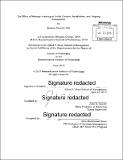The effect of message framing on initial choices, satisfaction, and ongoing engagement
Author(s)
Putnam-Farr, Eleanor
DownloadFull printable version (7.961Mb)
Alternative title
Yes/No/Not right now. Yes/No response formats can increase response rates even in non-forced-choice settings
Effect of benefit quantification on goal setting and persistence
Picture is worth a thousand words : photographs as anchors for expectations.
Other Contributors
Sloan School of Management.
Advisor
John R. Hauser.
Terms of use
Metadata
Show full item recordAbstract
Essay 1: "Yes/No/Not right now." Yes/No response formats can increase response rates even in non-forced-choice settings Although yes/no response formats have been used to increase enrollment rates in several different types of programs, their use has been largely limited to forced choice settings. Across two field experiments, we demonstrate a substantial advantage in click-through rates for a yes/no response format over traditional opt-in response formats in an email context where choice is not forced. The increase in click-through rate does, under certain conditions, also persist through downstream program enrollment and participation. Finally, though noting that the yes/no format advantage is probably multi-determined, we discuss several potential psychological mechanisms, which are particularly relevant in non-forced choice settings. Essay 2: The Effect of Benefit Quantification on Goal Setting and Persistence We look at how language used to describe rewards, specifically the quantification of an expected reward, might lead participants to create specific targets for their own performance based on that language. Through a combination of field and lab experiments, we demonstrate that the use of a high number to describe rewards leads to higher interest and enrollment, but also higher expectations of performance and a higher drop-out rate from the program when the reward is difficult to achieve. Marketers should be aware of this issue when describing benefits to potential customers, particularly if they wish to motivate persistent behavior. Essay 3: A Picture is Worth a Thousand Words: Photographs as Anchors for Expectations Marketers often use images to increase the vividness of their communications to customers. These images should make the message easier to process, thereby increasing liking for the product and certainty of expectations. In a series of experiments, I demonstrate that images do indeed increase certainty of preference estimates, both within and between respondents, but may have more mixed effects on the valence of estimates of preference. I also begin to examine how these estimates might impact evaluations of actual products and propose some areas for future exploration.
Description
Thesis: Ph. D., Massachusetts Institute of Technology, Sloan School of Management, 2015. Cataloged from PDF version of thesis. Includes bibliographical references.
Date issued
2015Department
Sloan School of ManagementPublisher
Massachusetts Institute of Technology
Keywords
Sloan School of Management.